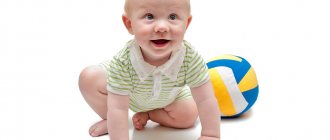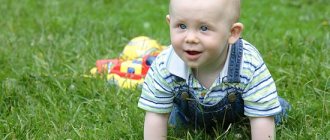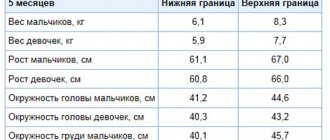At the age of one and a half years, children experience a real leap in development. We are talking, first of all, about vocabulary, level of intelligence, as well as physical skills.
Parents often compare the baby with other children to understand whether the child’s development at 1 year 6 months corresponds to the norm.
And it is during this period that mothers and fathers should be as attentive as possible in order to protect the child from possible problems in the future.
Physical development
A person’s somatic health depends on his physical characteristics. The main indicators of the level of physical development of a child are:
- body mass,
- height,
- head circumference (measured in children under 1 year of age),
- chest circumference and other standards that are measured by anthropometry.
REFERENCE.
Anthropometric research is the main method of studying the main indicators of the physical data of the human body. The values of anthropometric data depend on the sex of the baby, his heredity, and individual developmental characteristics. They may differ from the norm in one direction or the other.
Table 1. Anthropometric data of a child aged 1 year 5 months. Height.
| Boys | Girls | Note |
| 73.3 cm | 71.1 cm | significantly below normal |
| 76.0 cm | 74.0 cm | below normal |
| 78.6 cm | 76.8 cm | norm |
| 89.2 cm | 88.2 cm | high |
Table 2. Anthropometric data of a child aged 1 year 5 months. Weight.
| Boys | Girls | Note |
| less than 7.7 kg | less than 7.0 kg | significantly below normal |
| 8.6 kg | 7.9 kg | below normal |
| 9.6 kg | 8.9 kg | norm |
| 14.9 kg or more | 14.8 kg or more | above normal, inappropriate for age |
At this age, the child has from 8 to 12 teeth. The incisors erupt first, then the canines.
What should a child be able to do at this age? Here are the basic skills that the baby has:
- holding a spoon
- eats thick food
- drinks from a cup
- asks to go potty.
What should a 6 month old baby be able to do?
At six months, the child himself takes toys, examines them, knocks them, moves them from hand to hand, and can hold one toy in each hand at a time. The baby is happy if he managed to reach one or another desired object and gets angry if he fails or if an adult takes the object away from him for safety reasons.
A six-month-old baby is already trying to crawl: sometimes he manages to move backwards, sometimes “on his belly.” Six-month-old babies love to get on all fours and rock back and forth in this position - this exercise is a preparation for full crawling. Some children then sit down from this position.
At six months, the child already understands speech addressed to him, knows his name and turns to the adult who called him by name. The humming turns into babbling, the baby is able to repeat simple open syllables after an adult. The child reacts emotionally to music; some children may even try to “sing” while a piece of music is playing.
A six-month-old baby can already clearly distinguish between friends and strangers. It recognizes the voices of loved ones, even if they are in the next room. The attitude towards strangers becomes even more wary than before. The child looks closely at a stranger for a long time before making contact with him. He makes contact very selectively.
Many six-month-old babies know how to drink from a mug and try to use a spoon. Attempts are usually unsuccessful, but this is not the main thing. The main thing is that at six months the child already understands why a spoon is needed and what it needs to do.
Benchmark: a six-month-old baby knows how to ask to be held by his mother.
Walking
The baby confidently and without tension stands on his feet and orients himself in space. Children especially enjoy overcoming obstacles: moving at a side step on steps, bending, turning, stepping over obstacles. And what a joy it is to climb into a chair or on a sofa many times in a row and come back down the same number of times!
ATTENTION! At this age, the child is unusually active. He runs from room to room, to the kitchen, interacting with objects. The task of adults at this stage is to ensure the complete safety of the child, remove sharp objects, electrical appliances, matches and anything that could cause harm.
ADVICE FOR PARENTS. It is better to choose shoes with corrugated soles, lightweight, adjustable in fullness. For proper formation of the foot, it is necessary to purchase shoes with a hard heel, made from natural materials. It’s good if the sole is made using modern technologies and can serve as a shock absorber when jumping.
Outdoor games
The most favorite games for kids at this age are ball games. There are a great many of them. “Catch - catch! ", "Where did the ball go", "Throw the ball into the box", "Catch up with the ball", "Collect balls according to the color of the basket", "Jump like a ball" and others. In addition, any obstacles are suitable for developing movements: stairs, planks, uneven surfaces. The game with a sunbeam, “Hide and Seek”, “Sunshine and Rain”, “I’ll Catch Up - I’ll Catch Up” is a lot of fun.
Subject-manipulative activity
Object activity is the main activity at an early age. A favorite activity at this age is pulling out drawers, opening cabinet doors and throwing the contents onto the floor. But gradually the child begins to realize that the objects around him are objects that can be manipulated.
At the first stage of object activity, the child does not connect the object with the action. He can endlessly bang his spoon on the table or floor. Gradually, the baby begins to understand what each item is intended for. This is the second phase of objective activity. At the age of one year and five months, the child is just at this stage.
Subject educational games
Of the variety of object games for children 1 year 5 months old, the following are recommended:
- building a tower of 3 – 5 cubes;
- stringing rings on a rod in a certain order (“Pyramid”),
- collecting nesting dolls;
- stringing large beads on a cord;
- sand games;
- water games;
- various sorters in which it is necessary to correlate objects by shape, color and size;
- puzzles of two halves;
- games with cars and other vehicles;
- musical hammers, drums and other sounding toys.
Productive subject activity
During this age period, productive activity begins to form. This includes drawing, modeling, and design.
If the child is already familiar with finger drawing, then you can start drawing classes using pencils, felt-tip pens, and markers. If you are not yet able to paint on your own, then you should draw by placing the baby’s hand in the hand of an adult. Creative activity is formed very individually. Some people already at the age of one year knew how to draw “scrawling dolls” on a piece of paper, others are just starting out. This stage is called the staining stage. Despite this name, the artist’s works are worthy of being framed and displayed on the wall in the main room.
Additional tools you can use:
- paints,
- stamps,
- sponge
- toothbrushes,
- thick sticks with cotton wool wrapped around them,
- cotton pads.
ATTENTION! It is important to ensure that a child at this age learns to draw “from the elbow” and not “from the shoulder.”
In the genre of sculpting, young sculptors, with the help of an adult, can so far only play “sticking sticks”, making holes and indentations in dough or clay.
Construction involves the construction of towers, houses, garages from construction kits with large parts.
What should a 4 month old baby be able to do?
By four months, the baby not only holds his head while lying on his tummy, but also turns it freely. In this case, the child takes a characteristic pose: the tummy is pressed tightly to the surface on which the baby is lying, the hips are wide apart, and the feet are in the air. If the baby lies on his back, then he happily raises his arms and legs up, grabs his feet with his hands and tries to pull them into his mouth. Four-month-old babies love to be placed upright, held under the arms, and the little ones “dance” with pleasure.
At four months, the baby no longer just knows how to smile - he can laugh loudly with joy, but the response to an angry voice can already be crying. And the baby also begins to react to the change in the appearance of a loved one: the child will look at the mother in a new bright dress in surprise, and will try to cling to large jewelry or accessories.
Four-month-old babies enjoy touching and examining objects, and, of course, putting them in their mouths. The baby is already holding the toy placed in the handle and quite firmly, some children can even reach out and grab the toys themselves.
All healthy babies try to turn on their side in the fourth month. Four-month-old babies also love to play with sounds and syllables. They “sing” vowels in different ways and pronounce their first syllables by the age of four months.
Control indicators: a four-month-old baby must definitely reach out to the toy with his hands and try to grab it.
Nutrition
Gradually, the child is transferred from a five-meal to a four-meal diet. When creating a diet, parents need to focus on the child’s needs. If he gets up very early, then before breakfast you can organize a light snack: milk or kefir with cookies. If you go to bed late, and there are still 2-3 hours left from dinner to bed, then you can eat and drink something tasty before bed.
Table 3. Percentage of calories per feeding for four meals a day with a snack
| Calorie content | |
| Breakfast | 20 % |
| Dinner | 35 % |
| Afternoon snack | 15 % |
| Dinner | 20 % |
| Snack | 10 % |
Gradually, the child must be accustomed to new tastes. It is advisable to introduce each new product no more than once a week. In this case, you need to watch your skin. If rashes appear, you should stop taking the new product.
THIS IS INTERESTING. Nutritionists have noticed that to get used to an unfamiliar product, you need to eat it at least 10–15 times.
At this stage of age development, the technology of cooking changes. Small pieces are gradually introduced, because the baby must learn to chew food.
ATTENTION! There should be no fried foods on the menu of young children. Cooking is only possible by boiling, stewing or steaming. No pork is used. Meat dishes should be prepared from veal, chicken, turkey, and rabbit. Chocolate, mushrooms, seafood, and foods high in salt are also prohibited.
It is very important to instill in your baby cultural and hygienic skills during feeding from a very early age. Napkins, a bib, beautiful dishes - all these are integral elements of a meal.
Table 4. Sample weekly menu for a baby aged 1 year 5 months, taking into account the transitional nature of nutrition
| Day of the week | Breakfast | Dinner | Afternoon snack | Dinner | Snack (at the child's request) |
| Monday | Milk porridge. Wheat bread with butter. Cheese. | Vegetable soup. Steamed fish cutlets. Mashed potatoes. Kissel. Rye bread. | Kefir. Baked apple. Cookie. | Cottage cheese. Carrot puree. Milk. | Kefir. Wheat bread. |
| Tuesday | Liver paste. Mashed potatoes. Wheat bread. Cheese. | Oatmeal soup. Beef soufflé. Vegetable puree. Fruit juice. Rye bread. | Bun. Fruits. | Cottage cheese pureed with carrots. Mashed potatoes. Wheat bread | Yogurt. Rusk. |
| Wednesday | Rice milk porridge. Wheat bread with butter. Cheese | Cabbage soup Steamed beef cutlets. Vermicelli. Compote. Rye bread. | Beetroot puree. Cookie. | Cottage cheese casserole. Wheat bread. | Sweet tea. Apple. Wheat bread. |
| Thursday | Milk vermicelli. Omelette. Wheat bread with butter. | Rice soup. Green pea and potato puree. Berry juice. Rye bread. | Milk pudding. Morse. Cookie. | Cauliflower puree. Cottage cheese. Wheat bread. | Kefir. Wheat bread. |
| Friday | Buckwheat porridge. Egg. Cheese. Wheat bread with butter. | Milk soup. Chicken or turkey soufflé. Cereal side dish. Berry jelly. Rye bread. | Kefir. Apple. Crackers. | Herring pate with mashed potatoes. Wheat bread. | Milk. Wheat bread. |
| Saturday | Oatmeal porridge. Cheese. Wheat bread. | Vegetable soup. Rabbit cutlets. Vegetable puree. Fruit juice. Rye bread. | Bun. Fruits. | Cottage cheese with milk. Wheat bread. | Yogurt. Wheat bread |
| Sunday | Omelette. Buckwheat porridge. Wheat bread with butter. | Soup with green peas. Veal meatballs. Beetroot and carrot puree. Rosehip infusion. Rye bread. | Curdled milk. Crackers. Pear. | Curd pudding with sour cream. Wheat bread. | Kefir. Cookie. |
ADVICE FOR PARENTS. How to feed the “little one” and the “unwanted one”? First of all, you need to let your child move more and be in the fresh air. The second tip is interesting presentation of dishes. Meatballs in the shape of hares and piglets, omelettes in the shape of the sun and other inventions can be found on the Internet. It’s good if the child’s favorite character is depicted on the bottom of the plate. Then he will have to finish the dish in order to meet his friend.
Daily regime
Between the ages of 13 and 18 months, the transition to one nap during the day occurs. The child’s nervous processes have become more stable, and he needs more time to stay awake.
An approximate daily routine for a child who is ready for the transition or has already switched to one nap during the day:
| Time | Regime moments |
| 8.00 | getting up, morning hygiene procedures |
| 8.15 | breakfast |
| 8.30 | games, activities, exercises |
| 10.00 | lunch |
| 10.30 | walk |
| 12.30 | dinner |
| 13.00 | nap |
| 15.30 | afternoon tea |
| 16.00 | games, activities, exercises |
| 16.30 | walk |
| 18.30 | dinner |
| 19.00 | games, activities, exercises |
| 19.30 | evening hygiene procedures |
| 20.00 | night sleep |
ADVICE FOR PARENTS. Why doesn't the baby want to sleep? The reasons for reluctance to sleep may be: – overstimulation of the nervous system as a result of noisy and fun games shortly before bedtime; – no walks during the day; – transition to a new mode.
IMPORTANT! Only strict adherence to the regime will help avoid hysterics and whims, poor sleep, and loss of appetite.
Mental development
At the age of 1 year 5 months, the child is not yet aware of himself as an individual, but he begins to separate himself from all other people.
At this stage, the concept of norms of behavior begins to form. Therefore, at the age of 17 months, it is best to start explaining to your child what is possible and what is not. The concept of prohibition is formed.
The baby begins to understand that the world is not chaos, but a system. All components of the system are interconnected and can be influenced. At this age stage, mental activity is formed. The child is trying to understand the basics of the universe. He watches flying butterflies, moving vehicles, and connections are created in his head.
He really likes to imitate the actions of adults, because he is no longer so focused only on himself. For the same reason, he interacts with adults and other children.
Adults can find out the child's preferences. One baby is very passionate about music, another is very active in movements, and the third begins to develop speech at a rapid pace. Thus, psychological development at an early stage lays the foundations for the future.
What should a child be able to do per month?
In his first weeks of life, the child adapts to the outside world, gets used to a new existence outside the mother's womb. Many body systems are maturing: the thermoregulation system is still imperfect, and people are becoming accustomed to a different way of eating. Therefore, a newborn child is still very vulnerable and spends a lot of energy adapting to the outside world. And yet, by the end of the first month, babies have two significant developmental achievements: they begin to respond with a smile to close adults and try to hold their heads while being in an upright position.
A one-month-old baby can focus his gaze on a bright toy or the face of an adult and turns his head towards the sound source. He begins to show facial expressions and makes his first attempts to walk.
The development of a baby in the first month of life depends on whether the mother is nearby and how she behaves. Mom needs to constantly talk to the baby when he is awake. It is very useful to stroke the baby and do a light massage of the fingers and toes - this is a good stimulation of the nerve endings, the mother's touch calms, allows the baby to feel his body and feel peace and security.











